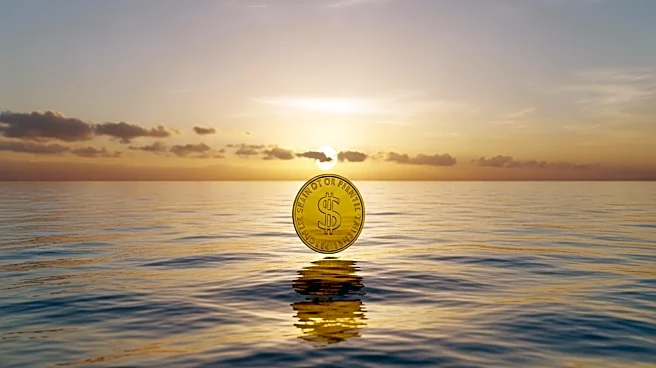What's Happening?
Gold prices have surged past the $4,000 mark per ounce, reaching a record high as investors seek refuge from ongoing economic and geopolitical uncertainties. This increase is also fueled by expectations of further interest rate cuts by the U.S. Federal Reserve. Spot gold rose by 0.5% to $4,002.53 per ounce, while U.S. gold futures for December delivery increased by 0.5% to $4,025 per ounce. The metal has seen a significant rise of 52% year-to-date, following a 27% increase in 2024. The rally is driven by a combination of factors, including anticipated interest rate cuts, political and economic instability, central bank purchases, and a weakening dollar. The U.S. government shutdown, now in its seventh day, has delayed the release of key economic indicators, prompting investors to rely on alternative data sources to predict the timing and extent of Fed rate cuts.
Why It's Important?
The surge in gold prices highlights the current economic climate marked by uncertainty and volatility. As a traditional safe-haven asset, gold's rising value reflects investor concerns over geopolitical tensions and economic instability. The expectation of further interest rate cuts by the Federal Reserve suggests a potential shift in monetary policy aimed at stimulating the economy. This could have significant implications for various stakeholders, including investors, financial markets, and policymakers. A weaker dollar and increased central bank buying further underscore the global economic challenges and the strategic moves by countries to diversify their reserves. The ongoing U.S. government shutdown adds another layer of complexity, affecting economic data availability and influencing market expectations.
What's Next?
Investors are closely monitoring the Federal Reserve's upcoming meetings, with a 25-basis-point rate cut anticipated this month and another in December. The continuation of the U.S. government shutdown could further impact economic data releases and market sentiment. Additionally, geopolitical developments, such as political unrest in France and Japan, may continue to drive demand for gold as a safe-haven asset. Analysts suggest that the market may aim for the next significant milestone of $5,000 per ounce, depending on the persistence of current economic and political conditions.
Beyond the Headlines
The current gold rally may have broader implications for global economic policies and reserve management strategies. As countries face mounting debt and economic challenges, the role of gold as a reserve asset may gain prominence. The diversification of reserves away from the dollar could signal a shift in global economic power dynamics. Furthermore, the 'fear of missing out' phenomenon among investors could lead to increased volatility in the gold market, affecting related commodities and financial instruments.











